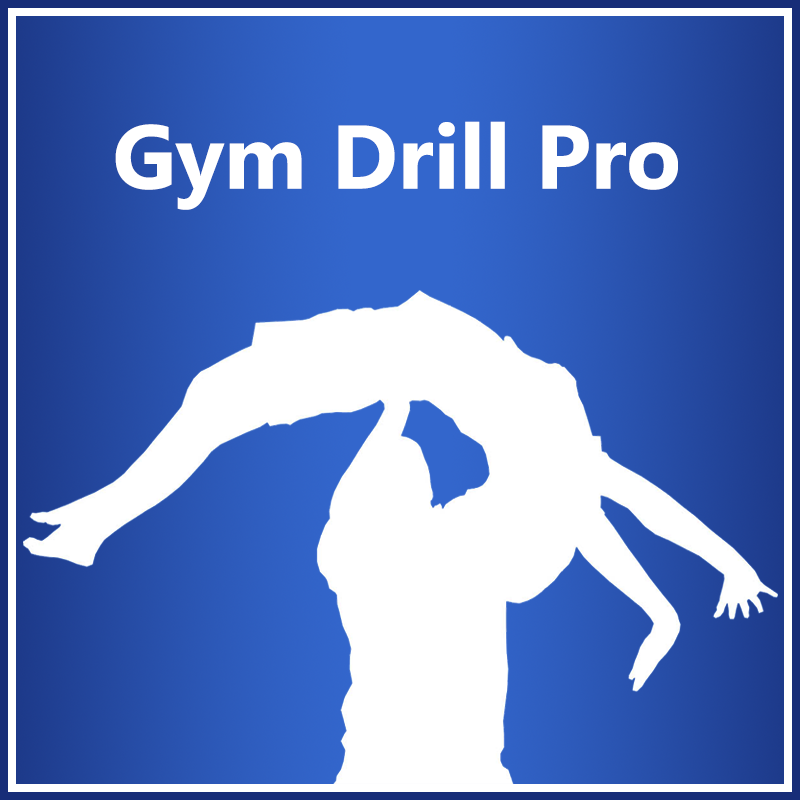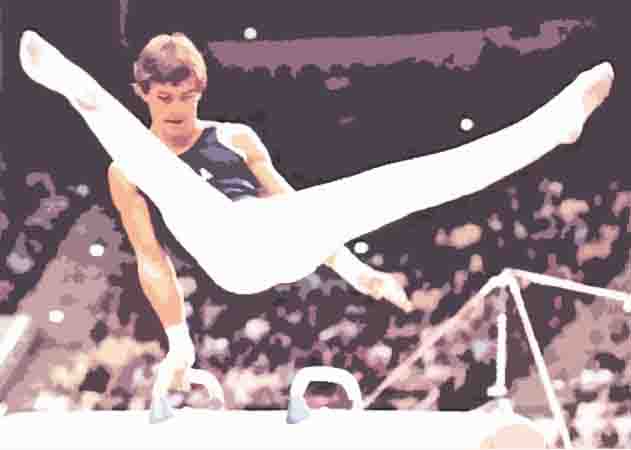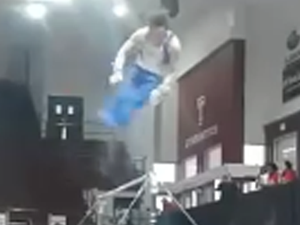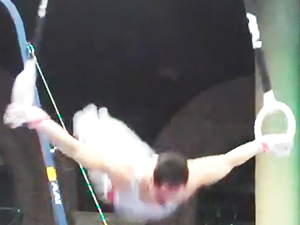

An integral part of the gymnastics coaching process is to provide athletes with drills to aid in their skill development. Drills can help gymnasts learn skills faster, and with the correct techniques. Gym Drill Pro aims to provide qualified coaches with a variety of teaching methods which they can introduce in their own training programs. On Gym Drill Pro you can find hundreds of detailed descriptions and accompanying images for every skill progression. This website is explicitly intended to support qualified coaches in their daily coaching processes. DO NOT practice any of these drills without the guidance of proper professionals.

The gymnast should follow the same rules required for a regular circle. The body should show full body extension throughout the circle. The flared circle begins at the front support with the legs beginning to separate immediately as the circle begins. There should be a minimum of a 135° straddle of the legs during the flared circle. In the front support and rear support, the legs are separated sideways in a horizontal plane. The leading leg raises through the ¼ position, then both legs switch their positions in the rear support. The leading leg in rear support moves to the side with a counter turn of the hips, allowing the lowered leg to provide the "heel kick" though the ¾ position. Then again both legs switch their positions and the circle finishes in front support with the legs wide open in horizontal.

The circle on mushroom is a basic drill for learning circles on pommel horse or beam. The gymnast should start learning circles early on in their career. This will help them develop higher quality circles with proper technique, because gymnasts can perform more repetitions overall if they start a younger age. To do this drill, the gymnast must first place their hands on the horizontal line across the mushroom. During the performance the athlete should not change this position of their hands. They should start in front support with their shoulders leaned slightly forward. They should face their hands forward with their fingers spread for better support. Next, they should step to the side opposite of their desired circle direction. The athlete does this opposite move, jumps in the desired direction, and closes their legs to start the circle. The entire circle should be performed with a completely straight body. There are several universal points that the gymnast should follow:
Maintain a completely extended circle with an open chest at first and third quarter;
The arms and legs should remain tight, no exceptions;
At the first quarter of the circle the base arm pushes the mushroom identically with the direction of the circle. In that quarter, the leading part of the body should be the hips. During the second quarter, the gymnast should put their other hand down, and finish the quarter in rear support;
In the third quarter, the gymnast should switch the support hand and start pushing down on the mushroom in the opposite direction from the circle trajectory. The leading part of the body during this phase are the heels;
In the fourth quarter, the gymnast should put their first hand back down on the mushroom and finish in front support. In order to assure continuity, the body should not touch the mushroom, and the shoulders should lean forward;
In the fourth quarter the gymnast put the first hand on the mushroom and finishes in front support. In order to assure continuity, the body should not touch the mushroom and the shoulder should lean forward.
During the execution of the skill, the shoulders lean in the opposite direction from the legs;
Developing a faster circle can help the gymnast lean less from their shoulders, maintain a straight body position easier, and raise their body higher above the mushroom (essential for performing floor circles, circles on the pommel horse, and beam).

The vault starts with a roundoff. The gymnast should execute a standard
hurdle,
raising their arms up and opening their shoulder angle. They should perform
a
strong kick from the back leg, and then push off the floor with their lunge
leg.
A the last moment, the gymnast should place their first hand sideways on the
floor. In the handstand position the legs should already be together. At
this
point the gymnast should turn another ¼ and place their second hand on the
floor. If performed properly, the gymnast should finish the half turn
slightly
before handstand in an extended, tight position. Next follows an effective
snapdown with a push from the hands. The round off should finish in a hollow
body position with the legs tight. The head should be slightly down with the
arms at horizontal so they can be ready for a strong kick back. The next
move is
the back handspring. The gymnast’s body should transform into a tight arch.
There must be a strong arm kick backwards. The gymnast’s head should be
slightly
open and follow the hands. The gymnast should reach the table slightly
before
handstand in an arched position. There are two methods for the blocking
action.
The first is a regular block, similar to how it would be performed on the
floor
- snapdown block. In this case the gymnast’s arms should push the surface
downward. After that, the upper body should transform into a hollow. The
second
method is pushing opposite (upward). This technique is more convenient for
high
difficulty skills such as Yurchenko layout, with twists, etc. It helps the
gymnast obtain a higher take-off. It’s suitable also for more experienced
gymnasts who have developed a faster run. After the snapdown the gymnast
should
perform a back tuck before landing on the floor.

In order to perform a Yamawaki, the gymnast must have a high back swing. The
Yamawaki can be performed using a variety of preliminary skills, including
Stemme, Free-Hip Stemme, or Front Giant. Regardless of the method used to
perform the Yamawaki, certain techniques for the skill remain the same.
During
the horizontal position in the downswing, the gymnast’s heels should begin
to
lead the swing with back pressure exerted against the bar from their hands.
This
will ensure an arched position which should continue until just prior to the
bottom of the swing. At this point, the hips should relax, and the body
should
quickly snap into a hollow position. The upper back and shoulders should
briefly
lead the swing before the gymnast releases into a second tight arched
position.
This secondary heel drive shortens the body and creates a turnover dynamic
that
will accelerate the body towards the horizontal position in the backswing.
At
this point the gymnast should press down on the bar and perform a
counter-move,
snapping and releasing over the bar in an upright hollow body. This
snap-down
should be executed with a twisting motion, so that the gymnast’s body will
be
rotated one quarter during the initial release. A strong press and snap-down
is
essential for providing the gymnast with enough height during the release to
reach a completely upright body position over the bar. After passing over
the
bar, the gymnast should continue twisting their body an additional quarter
and
begin to lean forward towards the bar. At this point, the gymnast has
already
completed a half turn and should lean towards the bar to catch it.

At the highest point in the back swing, the shoulders should be extended with
the
rings going slightly sideways. The body should be in an arched position.
From
the top of the swing, continuous shoulder extension toward the bottom of the
swing must be maintained. This helps the gymnast maintain the arched body
position until the bottom of the swing. At the bottom, the gymnast should
kick
the legs forward and upward to make their entire body turn over as fast as
possible. The gymnast should attempt to kick from their upper chest at the
bottom. Shoulder should remain extended and stay down until the entire body
turns over completely. The rings should be pushed backward when the
gymnast’s
feet are pointed towards the ceiling. The rings should turn parallel (wrists
facing one another). The rings should not go sideways during this portion of
the
swing. The final position is a higher point of the front swing, where the
body
should be in a slight hollow position with arms tight and parallel. The head
should be neutral with the gymnast maintaining backward pressure on the
rings.
From the highest point of the front swing starts the backswing. The body
should
swing down in a hollow position without losing pressure on the rings. At the
bottom, the gymnast should initiate a strong kick off their heels. During
the
turnover phase, the head should stay down to facilitate a stronger heel
lift.
Shoulders should remain low. When their heels have risen and their toes are
directed upward toward the ceiling, the rings can be slightly open, the head
will be slightly elevated as well. The final position of the backswing is
arched. VERY IMPORTANT: In the backswing, do not pull down on the rings. The
leading motion of the move is the kick back with the heels.